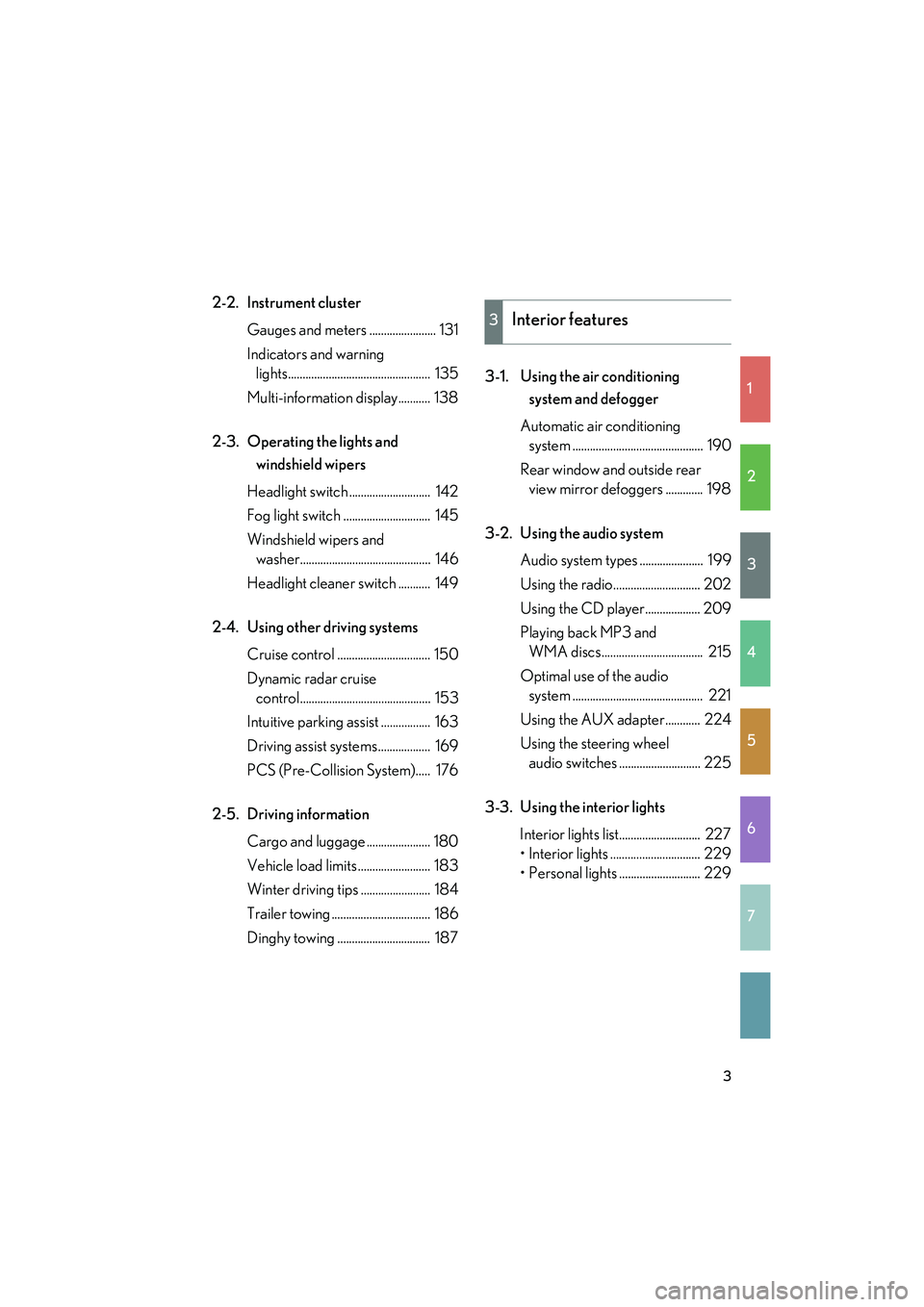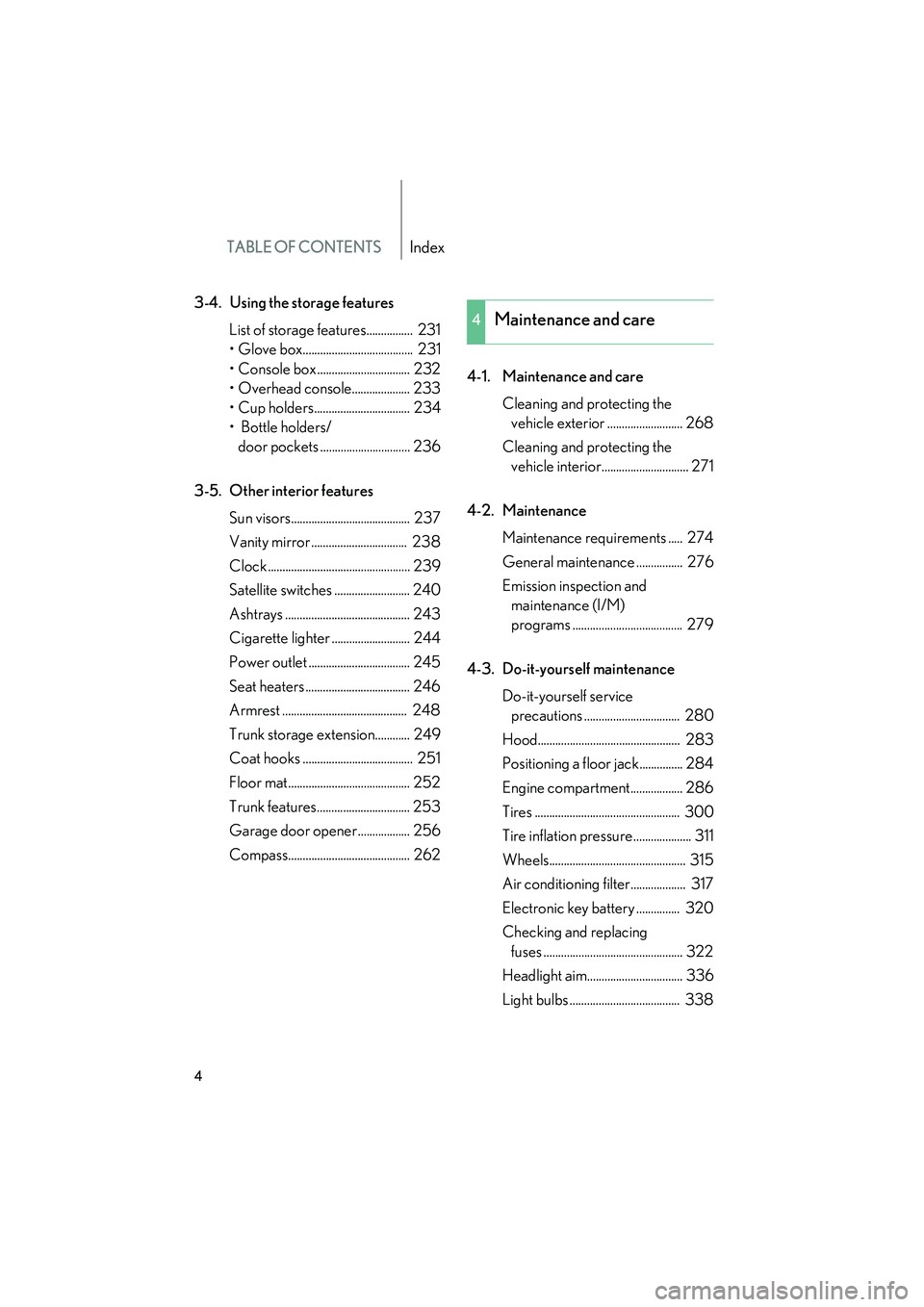2009 Lexus IS F air condition
[x] Cancel search: air conditionPage 2 of 458

TABLE OF CONTENTS
08_IS F_U_(L/O_0808)
1
1Before drivingAdjusting and operating features such as door locks, mir-
rors, and steering column.
2When drivingDriving, stopping and safe-driving information.
3Interior featuresAir conditioning and audio systems, as well as other interior
features for a comfortable driving experience.
4Maintenance
and careCleaning and protecting your vehicle, performing do-it-your-
self maintenance, and maintenance information.
5When trouble
arisesWhat to do if the vehicle needs to be towed, gets a flat tire,
or is involved in an accident.
6Ve h i c l e
specificationsDetailed vehicle information.
7For ownersReporting safety defects for US owners and seat belt in-
structions for Canadian owners
IndexAlphabetical listing of information contained in this manual.
Page 4 of 458

1
2
3
4
5
6
7
08_IS F_U_(L/O_0808)
3
2-2. Instrument clusterGauges and meters ....................... 131
Indicators and warning lights................................................. 135
Multi-information display........... 138
2-3. Operating the lights and windshield wipers
Headlight switch ............................ 142
Fog light switch .............................. 145
Windshield wipers and washer............................................. 146
Headlight cleaner switch ........... 149
2-4. Using other driving systems Cruise control ................................ 150
Dynamic radar cruise control............................................. 153
Intuitive parking assist ................. 163
Driving assist systems.................. 169
PCS (Pre-Collision System)..... 176
2-5. Driving information Cargo and luggage ...................... 180
Vehicle load limits ......................... 183
Winter driving tips ........................ 184
Trailer towing .................................. 186
Dinghy towing ................................ 187 3-1. Using the air conditioning
system and defogger
Automatic air conditioning system ............................................. 190
Rear window and outside rear view mirror defoggers ............. 198
3-2. Using the audio system Audio system types ...................... 199
Using the radio.............................. 202
Using the CD player................... 209
Playing back MP3 and WMA discs................................... 215
Optimal use of the audio system ............................................. 221
Using the AUX adapter............ 224
Using the steering wheel audio switches ............................ 225
3-3. Using the interior lights Interior lights list............................ 227
• Interior lights ............................... 229
• Personal lights ............................ 229
3Interior features
Page 5 of 458

TABLE OF CONTENTSIndex
08_IS F_U_(L/O_0808)
4
3-4. Using the storage featuresList of storage features................ 231
• Glove box...................................... 231
• Console box ................................ 232
• Overhead console.................... 233
• Cup holders................................. 234
• Bottle holders/door pockets ............................... 236
3-5. Other interior features Sun visors......................................... 237
Vanity mirror ................................. 238
Clock ................................................. 239
Satellite switches .......................... 240
Ashtrays ........................................... 243
Cigarette lighter ........................... 244
Power outlet ................................... 245
Seat heaters .................................... 246
Armrest ........................................... 248
Trunk storage extension............ 249
Coat hooks ...................................... 251
Floor mat.......................................... 252
Trunk features................................ 253
Garage door opener.................. 256
Compass.......................................... 262 4-1. Maintenance and care
Cleaning and protecting the vehicle exterior .......................... 268
Cleaning and protecting the vehicle interior.............................. 271
4-2. Maintenance Maintenance requirements ..... 274
General maintenance ................ 276
Emission inspection and maintenance (I/M)
programs ...................................... 279
4-3. Do-it-yourself maintenance Do-it-yourself service precautions ................................. 280
Hood................................................. 283
Positioning a floor jack............... 284
Engine compartment.................. 286
Tires .................................................. 300
Tire inflation pressure.................... 311
Wheels............................................... 315
Air conditioning filter................... 317
Electronic key battery ............... 320
Checking and replacing fuses ................................................ 322
Headlight aim................................. 336
Light bulbs ...................................... 338
4Maintenance and care
Page 14 of 458

08_IS F_U_(L/O_0808)
13
Without navigation system
Navigation
system
*
Clock
P. 239
Audio
system
P. 199
Air conditioning
system
P. 190
Rear window and out-
side rear view mirror
defoggers
P. 198
Security indicator
P. 71, 73
Emergency flasher
switch
P. 344
Clock P. 239
Audio system*
Security indicator
P. 71, 73
Emergency flasher
switch
P. 344
Air conditioning
system
*
With navigation system
*: Refer to “Navigation System Owner's Manual”.
Rear window and
outside rear view
mirror defoggers
*
A
Page 29 of 458

28
1-2. Opening, closing and locking the doors and trunk
08_IS F_U_(L/O_0808)
■Operation signals
A buzzer sounds and the emergency flashers flash to indicate that the doors have
been locked/unlocked. (Locked: Once; Unlocked: Twice)
■Conditions affecting operation
The smart access system with push-button start uses weak radio waves. In the fol-
lowing situations, the communication between the electronic key and the vehicle
may be affected, preventing the smart access system with push-button start from
operating properly:
(Ways of coping: →P. 3 9 1 )
●When the electronic key battery is depleted
●Near a TV tower, electric power plant, gas station, radio station, large display,
airport or other facility that generates strong radio waves or electrical noise
●When carrying a portable radio, cellular phone, cordless phone or other wire-
less communication devices
●When the electronic key is in contact with, or is covered by the following metal-
lic objects
• Cards to which aluminum foil is attached
• Cigarette boxes that have aluminum foil inside
• Metallic wallets or bags
•Coins
• Hand warmers made of metal
• Media such as CDs and DVDs
●When multiple electronic keys are in the vicinity
●When another wireless key (that emits radio waves) is being used nearby
●When carrying or using the electronic key together with the following devices
that emit radio waves
• Another vehicle's electronic key or a wireless key that emits radio waves
• Personal computer or personal digital assistant (PDA)
• Digital audio player
• Portable game system
●If window tint with a metallic content or metallic objects are attached to the rear
window
Page 81 of 458

80
1-7. Safety information
08_IS F_U_(L/O_0808)In certain types of severe frontal or side impacts, the SRS airbag system
triggers the airbag inflators. A chem
ical reaction in the inflators quickly
fills the airbags with non-toxic gas to help restrain the motion of the occu-
pants.
■SRS warning light
This warning light system monitors the airbag sensor assembly, front airbag sensors,
side and curtain shield airbag sensor assemblies, curtain shield airbag sensor
assemblies, driver's seat position sensor, driver's seat belt buckle switch, seat belt
pretensioner assemblies, inflators, interconnecting wiring and power sources.
( → P. 3 5 6 )
■If the SRS airbags deploy (inflate)
●Bruising and slight abrasions may result from contact with a deploying (inflating)
SRS airbag.
●A loud noise and white powder will be emitted.
●Parts of the airbag module (steering wheel, airbag cover and inflator) as well as
the front seats, and parts of the front pillar, rear pillar and roof side rail, may be
hot for several minutes. The airbag itself may also be hot.
●The windshield may crack.
■SRS airbag deployment conditions (front airbags)
●The front SRS airbags will deploy in the event of an impact that exceeds the
set threshold level (the level of force corresponding to a 12 - 18 mph [20 - 30
km/h] frontal collision with a fixed wall that does not move or deform).
However, this threshold velocity will be considerably higher if the vehicle strikes
an object, such as a parked vehicle or sign pole, which can move or deform on
impact, or if the vehicle is involved in an underride collision (e.g. a collision in
which the front of the vehicle “underrides”, or goes under, the bed of a truck, etc.).
●It is possible that in some collisions where the forward deceleration of the vehi-
cle is very close to the designed threshold level, the SRS front airbags and the
seat belt pretensioners may not activate together.
●The SRS front passenger airbag will not activate if there is no passenger sitting
in the front passenger seat. However, the front passenger airbag may deploy if
luggage is put in the seat, or the seat belt is fastened, even if the seat is unoccu-
pied. ( →P. 8 9 )
Page 82 of 458

81
1-7. Safety information
1
Before driving
08_IS F_U_(L/O_0808)
■SRS airbag deployment conditions (side and curtain shield airbags)
●The SRS side airbags and SRS curtain shield airbags will deploy in the event of
an impact that exceeds the set threshold level (the level of force corresponding
to the impact force produced by a 3300 lb. [1500 kg] vehicle colliding with the
vehicle cabin from a direction perpendicular to the vehicle orientation at a
speed of 12 - 18 mph [20 - 30 km/h]).
●The SRS side airbag on the passenger seat will not activate if there is no passen-
ger sitting in the front passenger seat. However, the side airbag on the passen-
ger seat may deploy if luggage is put in the seat, even if the seat is unoccupied.
(→ P. 8 9 )
■Conditions under which the SRS airbags may deploy (inflate), other than a colli-
sion
The SRS front airbags may also deploy if a serious impact occurs to the underside of
your vehicle. Some examples are shown in the illustration.
■Types of collisions that may not deploy the SRS airbag (front airbags)
The SRS front airbags are generally not designed to inflate if the vehicle is involved
in a side or rear collision, if it rolls over, or if it is involved in a low-speed frontal colli-
sion. But, whenever a collision of any type causes sufficient forward deceleration of
the vehicle, deployment of the SRS front airbags may occur.
●Hitting a curb, edge of pavement or hard
surface
●Falling into or jumping over a deep hole
●Landing hard or vehicle falling
●Collision from the side
●Collision from the rear
●Vehicle rollover
Page 90 of 458

89
1
1-7. Safety information
Before driving
08_IS F_U_(L/O_0808)
Front passenger occupant classification system
Your vehicle is equipped with a front passenger occupant classification sys-
tem. This system detects the conditions of the front passenger seat and
activates or deactivates the devices for front passenger.
SRS warning light
“AIR BAG OFF” indicator light
“AIR BAG ON” indicator light
Front passenger’s seat belt reminder light